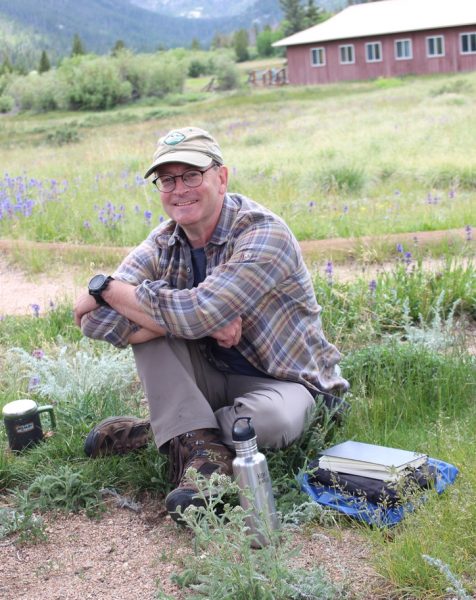
This summer marked the launch of a new summer program in Environmental Humanities—a combination of three courses in history, writing, and philosophy that are designed to be taught, experienced, and lived at CSU’s Mountain Campus. The courses are offered in two-week blocks, one after the other, in early summer.
Ken Shockley, an environmental philosophy professor and founding director of the program, describes the vision: “the idea behind the program is really about bringing together different people with different backgrounds to focus on a particular topic and set of conceptual questions. Their close proximity in a semi-wild environment provides a really deep, enriched, and memorable experience.”
It was the availability of the Mountain Campus, with Rocky Mountain National Park sitting adjacent, that Shockley and colleagues found to be “a beautiful opportunity to get that ultimate liberal arts experience.” Historically, students in forestry, ecology, and other natural resources disciplines have frequently taken advantage of the campus. For example, Warner College student Teagan Bryan came to CSU specifically for the Mountain Campus. “It is everything I want. It’s nature, it’s beautiful. It feeds my soul.”
After teaching his own environmental ethics course at the Mountain Campus since 2018, Shockley saw the opportunity to broaden humanities’ reach into the wilderness and into students’ broader imagination and education. One of this summer’s CLA students, Tatum Libby, describes her draw to the program. “I saw this class and I got super excited about it right away. I knew I wanted to be a part of it because it combines two things that I love very much: the natural world and philosophy. So, I was excited about doing it, and being up at the Mountain Campus just like made it a selling point for me.”
A Sense of Place
While a COVID outbreak abruptly changed the trajectory of the first two courses, professors Sarah Payne and Matthew Cooperman were able to pivot to place-based courses with excursions to areas in and around Fort Collins. Despite not being at the Mountain Campus for the entirety of each course, the students had the benefit of dialogue and reflection while traveling in vans on their way back to Fort Collins each day. The program did culminate as planned with Shockley’s environmental ethics course in residence at the Mountain Campus for the final two weeks.
The connection to the land and to a particular place is central to the experience for both Shockley and the students. As students begin to feel at home in the mountains, Shockley observes them finding “their place” where they return for quiet reflection. Their study becomes more and more embodied. Cameron Tolar, an Ecosystem Science and Sustainability major, describes how the setting “puts you in the kind of place you’re learning about. We’re learning about the environment and we’re in the environment essentially, or, at least, a more natural state of it. It makes you feel more in tune with your surroundings.”
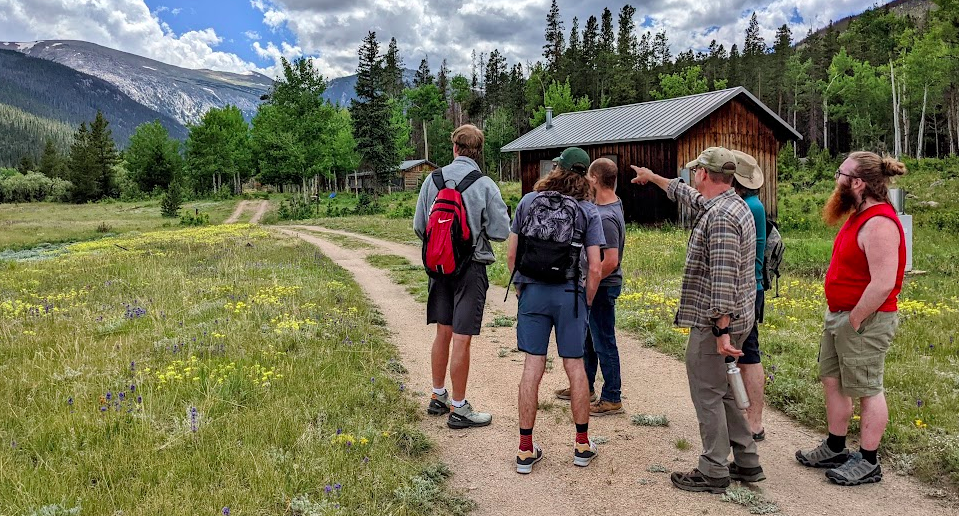
The connection with nature really drives home the students’ connection to their learning. Sociology major Sam Hanek describes her experience, “I think it’s significant that we’re in a philosophy class and considering how we should behave and act towards the environment. It’s really hard to think about that and to truly understand if you’re in classroom and looking at Google stock images of trees. But when you’re here, you can genuinely feel that connection. You can also get in the mindset of the authors because we’re in the environment that we’re learning about. It’s just totally different and it’s significantly better.”
Hiking-driven pedagogy
Shockley’s course design can be described as a series of increasingly difficult hikes with a substantial amount of reading and conversation in between. The class begins with shorter hikes that integrate discussion prompts at the beginning and middle of the hikes. “We hike for a bit and then we’ll get to the top of the hill. We look down. We talk about ‘thinking like a mountain’ or some grandiose theme from the reading they’ve just done. And I tie that to the place we are at, and we share in that experience.”
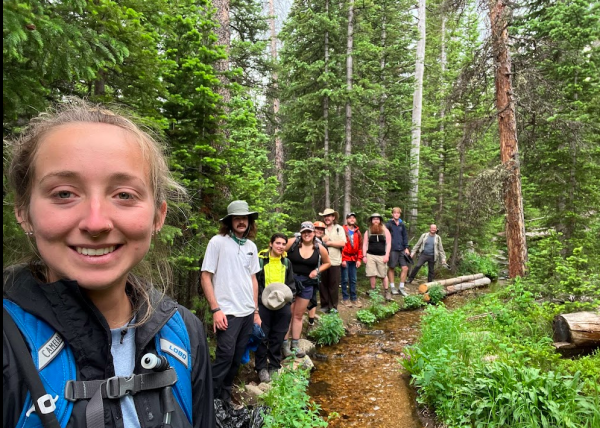
Shockley notes how students navigate their conversations while hiking and they start to become in sync with the width and movements of the trails. While on a mid-range hike up to Cirque Meadows, Shockley explains how “there’s a pattern to it, so your dynamics on the trail and your dynamics in conversation are supposed to match.” Tolar found this kind of pedagogy to be critical to his learning, “I think it’s really engaging. I have a lot more stamina to learn when I’m in an invigorating environment and we’re learning in different places all the time. Being in different spots and having focused discussions opened my mind to learn in a different way.”
While the class flows in a very natural way through the history, literature, and theoretical frameworks of environmental ethics through these different hikes, Shockley has carefully crafted opportunities to increase the impact on the student experience. For one example, he explains that “if I plan it just right, and get a little lucky, we’ll get to the lake just in time to watch the osprey feed.” These moments are not lost on the students. Libby shares, “I think one of the coolest things about having class out here and learning in this experiential way is that you gain so much supplementary knowledge that you would never get in a classroom. It’s one thing to talk about nature and the environment, but it’s a whole other thing to be fully immersed in it.” In addition, the students were excited to share their search for moose with Shockley in the evenings, special eye-to-eye encounters with various wildlife, and the joys of waking up to deer right outside their cabins.
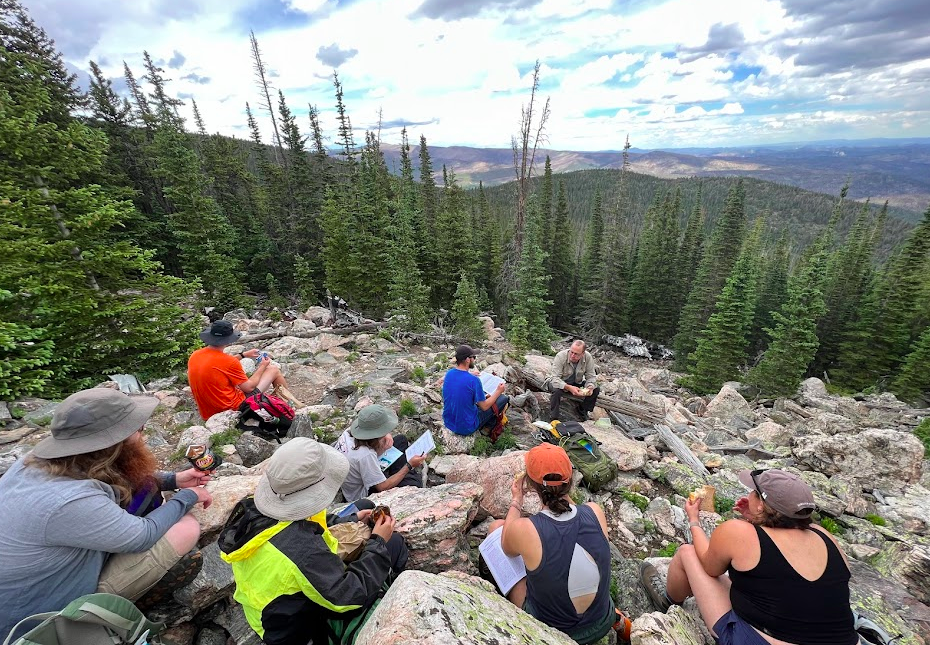
In the second week of class, the hikes get longer and more intense. The themes then shift to more applied topics, like ecological restoration. To delve deeply into the material, Shockley leads the students to the site of a B17 crash higher up on the range. He describes the trail as having all manner of layered landscapes that demonstrate the different ways humans have impacted it, and how, over time, humans and the other-than human world have coevolved.
“We talk about it and as we’re talking they’re seeing it in the land. It’s written in the land around them. It’s such a rich exercise in experiential learning. And then at the top, there’s also symbolic value tied up in the place where we can see the B17 wreckage; and we can ask about why we think of this as sacred ground. And we look out and see these great rocks and the edge of the mountains and there in front of you is death.”
Human Connections
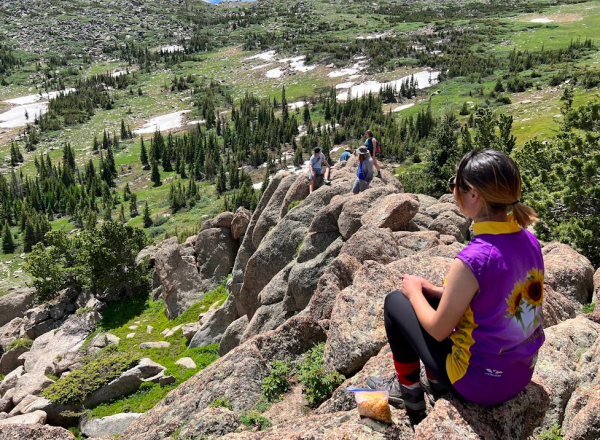 In addition to the felt connection to place and nature, the students form very close bonds with each another. This is most apparent when students set out on an alpine hike near the end of the course. Last year, Shockley led the group to Stormy Peak, a 13+-mile hike with over 3000 feet of elevation gain. “That’s a serious serious hike. It’s an all-day adventure. It’s hard. For me, it’s hands down the most beautiful hike here. Whether people can make it or not is a different question.”
In addition to the felt connection to place and nature, the students form very close bonds with each another. This is most apparent when students set out on an alpine hike near the end of the course. Last year, Shockley led the group to Stormy Peak, a 13+-mile hike with over 3000 feet of elevation gain. “That’s a serious serious hike. It’s an all-day adventure. It’s hard. For me, it’s hands down the most beautiful hike here. Whether people can make it or not is a different question.”
The hike works its way through different kinds of forests and landscapes from dense and wet woods of pine and fir to meadows of flowers and blueberries to sharp rock faces where students sit and talk while taking in the best views of the valley below. Shockley describes how his last class made it just below the rock piles at the summit, with just a quarter-mile scramble left to go. Then, one of the students sadly said that she couldn’t go any further and that she was just done with the hike. “And all the students said ‘it’s okay; it’s all right; we’ll stop here.’ It was beautiful because we had been at this all day to get to that one spot and the whole class said ‘no, this is enough.’ They were cool with it. It made me so happy. It was so beautiful.”
Diversity of Perspectives
While being immersed in nature and creating powerful and life-changing experiences seems to be a lofty enough goal, Shockley’s aims are even bigger and more significant. “My aim is for students to realize that the individual point of view of anybody on the environment is essentially limited. As I tell my students, one of the central themes of the course is that only through the ethical recognition of other points of view as legitimate do we get the epistemic advantage of a shared understanding of our environment. Only by recognizing others can we get a better view of our shared world. I think this is essential in almost every applied field, but definitely for environmental ethics.”
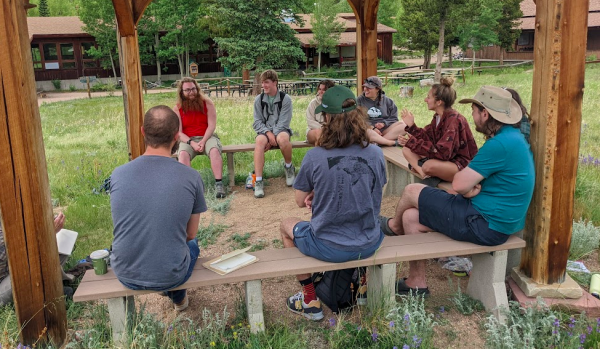 Some of Shockley’s favorite moments are watching this process in real time. “It’s so cool to see them walking together and sharing and disagreeing and agreeing. It’s so fun and it is effective. After just a week, they’re already talking about how things have changed about their perspectives. And it’s not just about this place and wanting to come back, it’s about changing the direction of their lives.” As Bryan succinctly puts it, “I think being here just changes everything.”
Some of Shockley’s favorite moments are watching this process in real time. “It’s so cool to see them walking together and sharing and disagreeing and agreeing. It’s so fun and it is effective. After just a week, they’re already talking about how things have changed about their perspectives. And it’s not just about this place and wanting to come back, it’s about changing the direction of their lives.” As Bryan succinctly puts it, “I think being here just changes everything.”